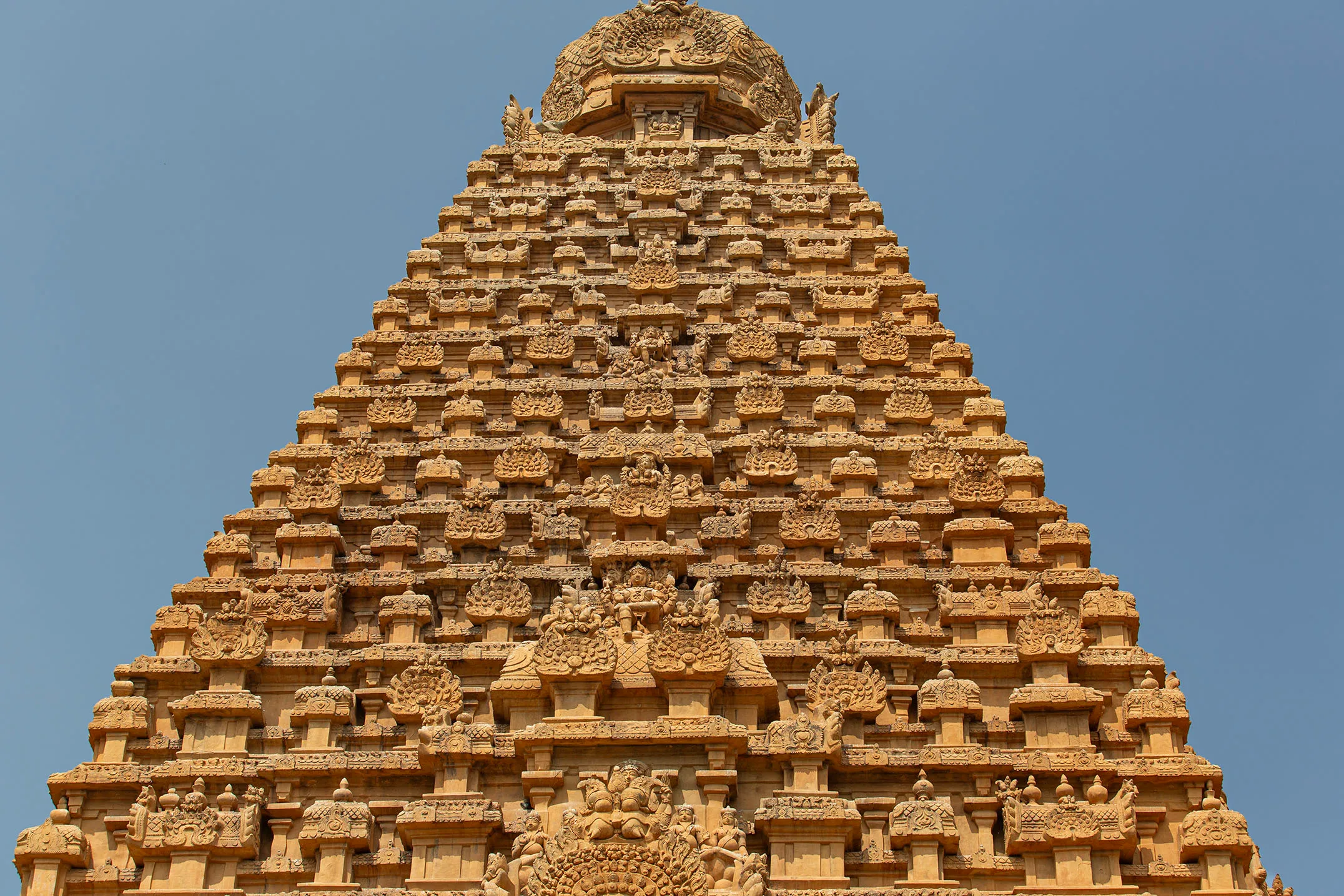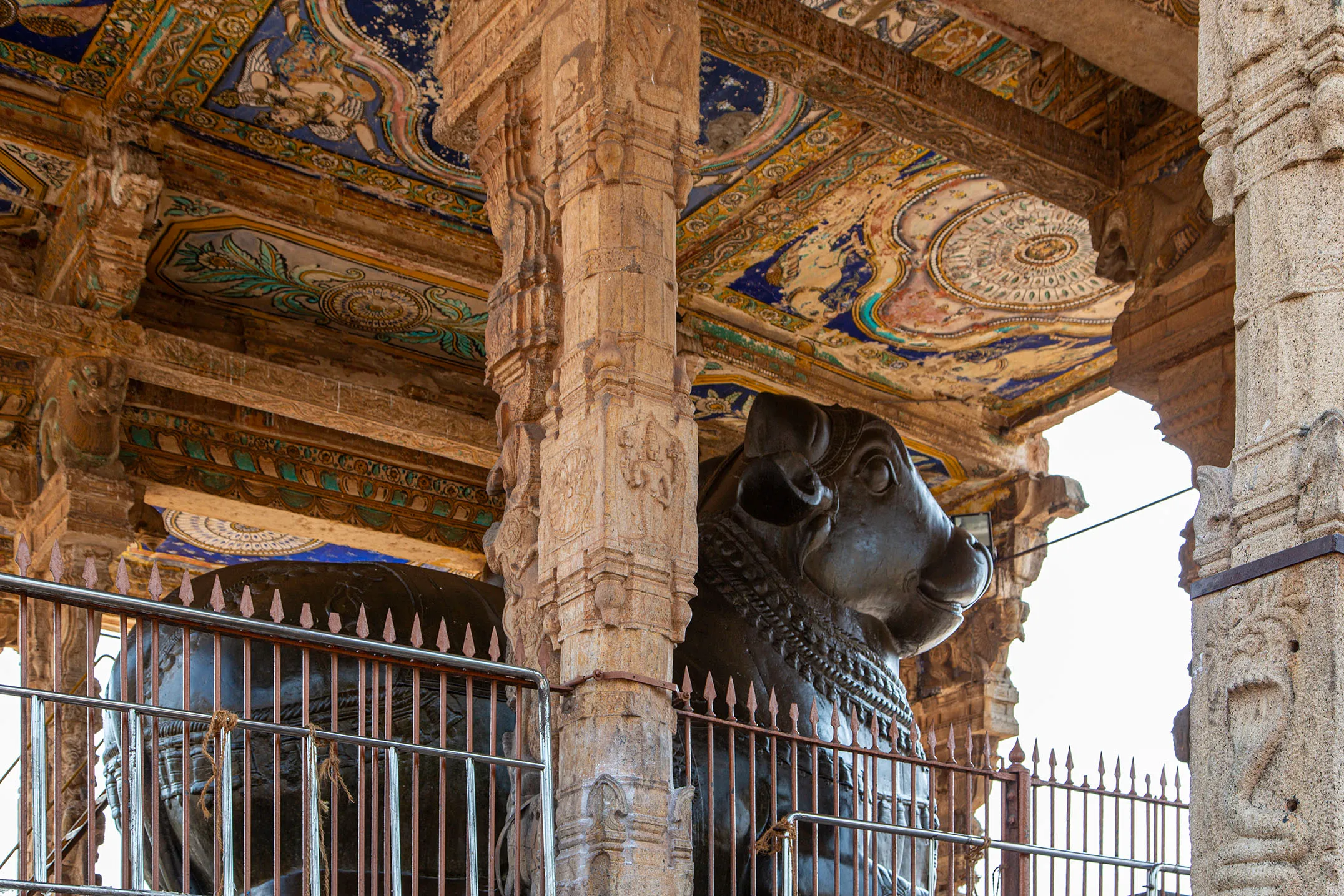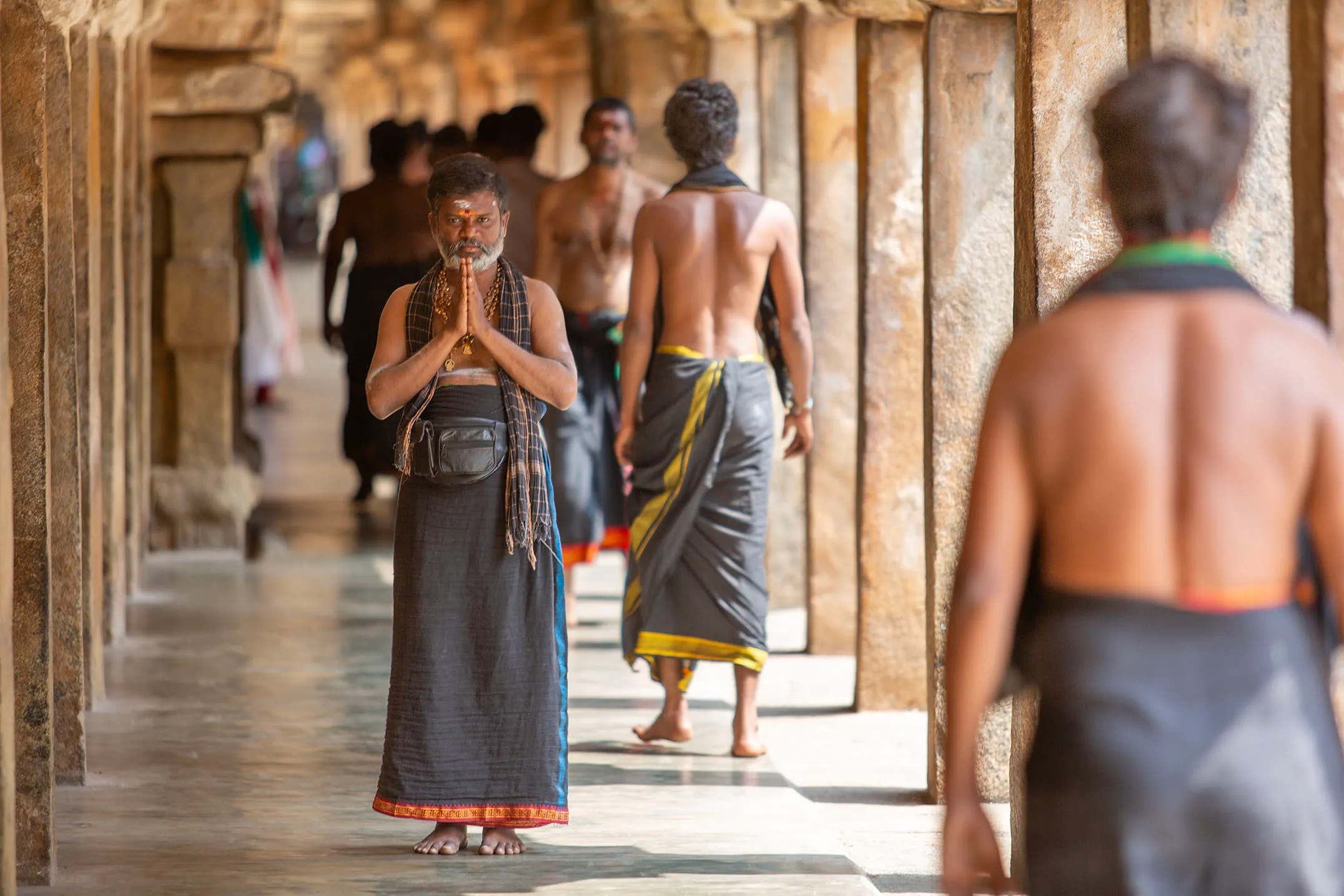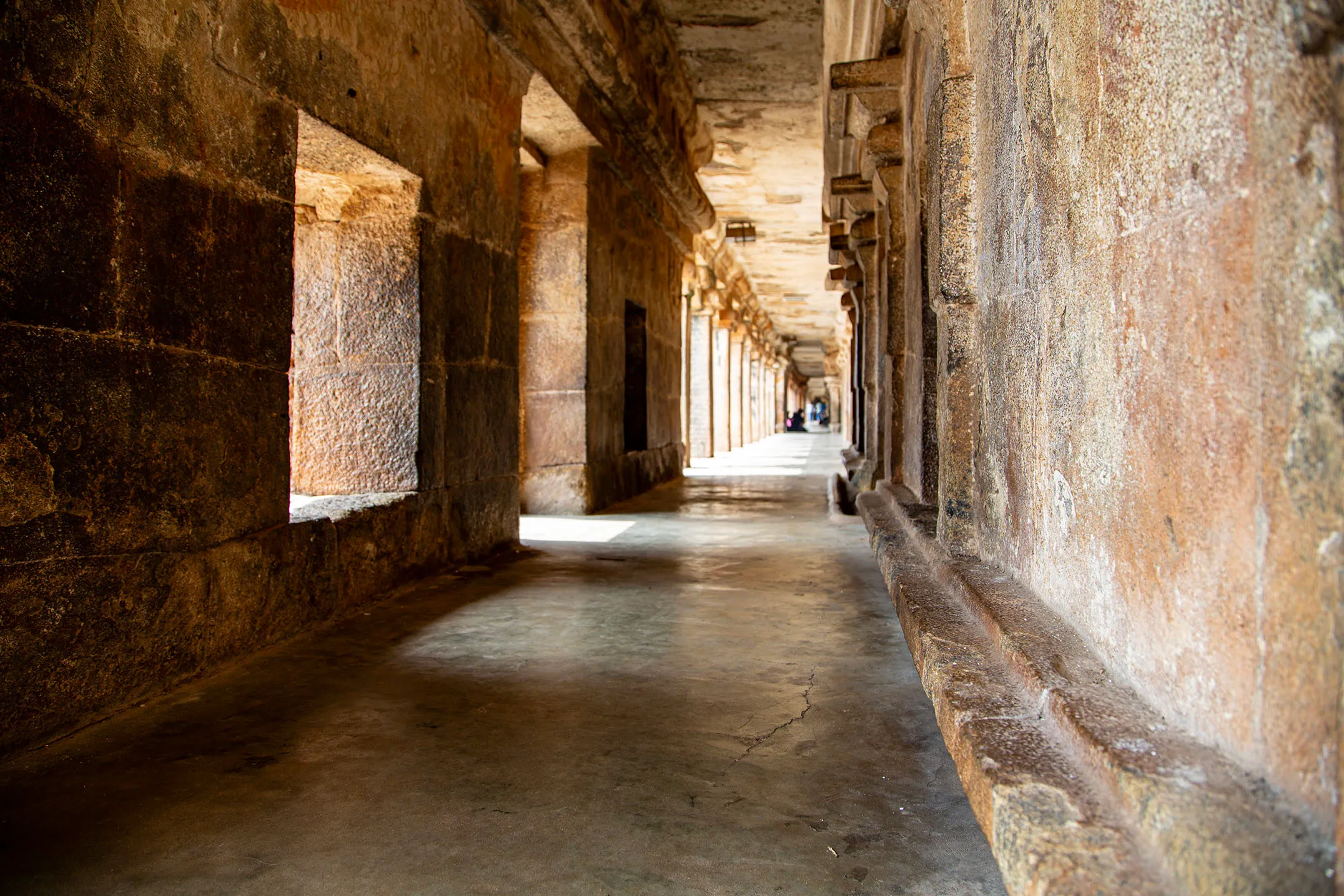Brihadeeswarar Temple
Words, voices and images: Connecting to cultures around the world
Words, voices and images: Connecting to cultures around the world


It is mid January and we are in Tamil Nadu. The southern Indian light still bright, and its sun, still warm as we visit a favourite place for another story about the architecture and buildings of India.
Brihadeeswarar Temple or Rajarajeswaram Temple, also known as the Thanjavur Big Temple is precisely as its name describes, BIG. It is also ancient, 1000 years old and older still. The temple was constructed by Chola King Raja Raja 1 and is part of UNESCO’s Great Living Chola Temples World Heritage Site.

UNESCO describes these Chola Temples:
“The Great Living Chola Temples were built by kings of the Chola Empire, which stretched over all of south India and the neighbouring islands. The site includes three great 11th and 12th century Temples: the Brihadisvara Temple at Thanjavur, the Brihadisvara Temple at Gangaikondacholisvaram and the Airavatesvara Temple at Darasuram. The temples testify to the brilliant achievements of the Chola in architecture, sculpture, painting and bronze casting”.
The Great Living Chola Temples have been under the protection of the Archaeological Survey of India for many decades. All are now established under the Tamil Nadu Hindu Religious and Charitable Endowments Act, 1959, from the time of its enactment.


The Brihadeeswarar Temple includes a central shrine, vestibule, Mukha mandapa, Nandi mandapa, a large courtyard and shrines. There are paintings and sculptures of various periods, all created with great skill, with the original paintings of the Chola period being rediscovered in 1930.


The temple, an art of brilliance, by Raja Raja 1 was built between the years 1003 and 1010 CE (AD) and was designed to represent a cosmic structure, the Mahameru.
The temple is dedicated to Siva represented by a linga (3.66 metres high) and named Rajarajajesvaramuddayar and after the King. The temple was built in a courtyard measuring 240 by 120 metres in the ratio of 1:2 with granite blocks being carted over a distance of 50 kilometres.

The Vimana rises to a height of 61 metres and the stone Sikhara at the top of the structure weighs just over 81 tonnes (it is composed of eight parts).
The inner sanctum is a square. There is a Pradakshinapatha, a circumambulatory passageway around the sanctum. The lower passageway is full of exquisite paintings from the Chola period.
The complex has the main temple with five sub-shrines for Chandikesvara, Amman, Subrahmanya, Ganesa and Karuvur Devar, the Royal Priest.

There are two mandapas for Nataraja and Nandi. A cloister mandapa runs around the compex. Two gopuras, Rajarajan tiruvasal and Keralantaka are of the same period as the main temple, the arch is from the Maratha period.
The walls in the temple complex are covered by inscriptions from the Chola, Pandya, Vijayanagara, Nayaka and Maratha periods. Niches in the lower wall of the temple contain various deities including Ganesa, Vishnu, Shridevi, Bhudevi, Bhikshatana, Kalantaka, Natesa, Ardhanarisvara and Chandrasekhara. The upper wall represents the figure of Tripurantaka.

Brihadeeswarar Temple or Rajarajeswaram Temple, also known as the Thanjavur Big Temple is precisely as its name describes, BIG. It is also ancient, 1000 years old and older still. The temple was constructed by Chola King Raja Raja 1 and is part of UNESCO’s Great Living Chola Temples World Heritage Site.

UNESCO describes these Chola Temples:
“The Great Living Chola Temples were built by kings of the Chola Empire, which stretched over all of south India and the neighbouring islands. The site includes three great 11th and 12th century Temples: the Brihadisvara Temple at Thanjavur, the Brihadisvara Temple at Gangaikondacholisvaram and the Airavatesvara Temple at Darasuram. The temples testify to the brilliant achievements of the Chola in architecture, sculpture, painting and bronze casting”.
The Great Living Chola Temples have been under the protection of the Archaeological Survey of India for many decades. All are now established under the Tamil Nadu Hindu Religious and Charitable Endowments Act, 1959, from the time of its enactment.


The Brihadeeswarar Temple includes a central shrine, vestibule, Mukha mandapa, Nandi mandapa, a large courtyard and shrines. There are paintings and sculptures of various periods, all created with great skill, with the original paintings of the Chola period being rediscovered in 1930.


The temple, an art of brilliance, by Raja Raja 1 was built between the years 1003 and 1010 CE (AD) and was designed to represent a cosmic structure, the Mahameru.
The temple is dedicated to Siva represented by a linga (3.66 metres high) and named Rajarajajesvaramuddayar and after the King. The temple was built in a courtyard measuring 240 by 120 metres in the ratio of 1:2 with granite blocks being carted over a distance of 50 kilometres.

The Vimana rises to a height of 61 metres and the stone Sikhara at the top of the structure weighs just over 81 tonnes (it is composed of eight parts).
The inner sanctum is a square. There is a Pradakshinapatha, a circumambulatory passageway around the sanctum. The lower passageway is full of exquisite paintings from the Chola period.
The complex has the main temple with five sub-shrines for Chandikesvara, Amman, Subrahmanya, Ganesa and Karuvur Devar, the Royal Priest.

There are two mandapas for Nataraja and Nandi. A cloister mandapa runs around the compex. Two gopuras, Rajarajan tiruvasal and Keralantaka are of the same period as the main temple, the arch is from the Maratha period.
The walls in the temple complex are covered by inscriptions from the Chola, Pandya, Vijayanagara, Nayaka and Maratha periods. Niches in the lower wall of the temple contain various deities including Ganesa, Vishnu, Shridevi, Bhudevi, Bhikshatana, Kalantaka, Natesa, Ardhanarisvara and Chandrasekhara. The upper wall represents the figure of Tripurantaka.

“Every icon is at once a symbol and a representation, the worshipper, though he knows that the deity takes the forms that are imagined by his worshippers is nevertheless persuaded that the form is like the deity” Dr Amanda Coomaraswamy.
The origins of the skills of southern India’s stone and metal workers are ancient. Writings in Tholkappiyam, the earliest grammar in the Tamil language, refer to creating tombstones for warriors called Veerakkal. It is possible that this tombstones contained some form of imagery and that takes us back to around 300 BC. In the early period there were classifications of land terrain and each is likely to have had a deity, namely Murugan, Thirumal, Korravai and Indiran. Again it is not possible, for lack of archaeological evidence, to conclude that these deities were actually worshipped in the anthropomorphic forms.


Indian scholars can infer from the literature from these early times that temples did exist. If images did exist, which is of course likely, it is not clear wether stone and metal were used extensively to create these images. Clay, brick and mortar may have been used.

Although shrouded in the mysteries of the distant past what can be inferred is that the art of image making was known to the early Tamils and that worship of these images was likely.
The Bhakti-cult in Tamilnad developed in the period between the 4th and 10th centuries AD. The age of the Alwars (Poygai Alwar) extended from the 5th to the 9th centuries. This was a period of literary outpouring and preachings with the resulting deepening of religious fervour and demand for temples as places of worship. So we can speculate that the development of temple construction can be traced to the Bhakti movement.

Records remain from the early Pallava period that traces the development of temples and the patronage of Kings in the development of the art of temple construction and imagery. Thus the era of stone architecture and construction of temples was born, replacing the earlier brick and timber buildings. Successive Pallava Kings continued to show great enthusiasm for the construction and carving of temples. The rock cut temples of Mahabalipuram are just one example.

Following the craving of temples from rock formations, structural temples, that is the making of temples from individual and shaped stones, was the second phase of the stone building of temples in South India. The temples at Mamallapuram and Panamalai and the temples of Kailasanath and Vaikunta Perumal at Kanchi are the earliest structural stone temples in South India.
With the rise of the Chola dynasty from 846 AD, a new phase of temple building began. Until this period no big temple had been built. And so we come full circle and back to our Brihadeeswarar Temple.

Tradition has it that great care must be taken to select the right type of stone for the image. Blemishes that might bring ill luck are to be avoided.
From the ancient texts or Silpasastra.
“The stone should be cut in an auspicious month, during auspicious thithi and lagna and during the ascendancy of a benefic star, on a good day. While starting, on the way and while collecting the stone, he (the Acharya) should carefully observe the omens on the land and in the sky.
Crows traversing from left to right, eagles crossing from right to left, seeing a virgin or a cow, encounters with herds of cows, a pot full of curd, flowers in blossom, garlands of flowers, women with children, rice, meat, devotees of Siva, flaming cinders, a pitcher filled with water, robed elephants and beautiful prostitutes, these are all good omens and portend good results".
There is also a long list of things that are not a good omen and portend evil results. So the journey to collect the stones was long and complex and all that was before the carving could commence.
